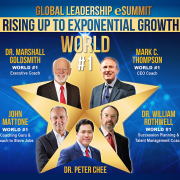The CEO Myth – Being The Ultimate Decision Maker
A common misperception about the CEO’s role is that they are the ultimate decision-maker, and that the prize of getting this coveted position is that you now get to make all the decisions. In reality, the CEO’s role is much more about shaping rather than making decisions.
There’s a fundamental reason for this subtle difference. Organisations face countless decisions daily, and it would be impossible for a CEO to be involved in each one. Attempting to do so would slow down the entire operation and could even bring it to a standstill. As a result, rather than making decisions directly, the proper role of the CEO is to enable others to make decisions the CEO can support. Of course, there are times when the CEO must be the ultimate decision-maker, but the CEO’s approach should be inspired by Occam’s razor: The fewer decisions the CEO can make, the better.
CEOs have several tools at their disposal to shape decisions in their organisations. Some are at the level of the organisation as a whole. CEOs can shape decisions by aligning everyone around a shared purpose, articulating priorities, and setting goals. Decisions are also shaped by developing a clear strategy, adopting an organisation structure that allows for the proper distribution of responsibilities, and fostering a strong culture. A clear performance measurement and reward system can also help.
Even as they build the broader context that shapes decisions across the organisation, CEOs cannot step away from decision-making entirely. Indeed, they must choose where and how they personally engage in decision-making.
The decision-making landscape in any organisation is vast. A useful map is to think of categories of decisions on one axis (e.g., strategy, structure, culture, people, products, investments, etc.) and the organisational level at which decisions need to be made on the other axis (e.g., corporate, business unit, region, function, subsidiary, plant, office, etc.). CEOs must choose how to personally engage to shape decisions across this entire landscape. This involves, at each intersection of category and level, determining the extent to which they are involved in designing the decision-making process, choosing when to participate directly, monitoring the work, and creating clarity around when and by whom a decision will be made. This framework is based on the 25 years I have spent alongside colleagues teaching CEO workshops at Harvard Business School, as well as my own experience leading organisations and advising CEOs as a board member and advisor.
Designing the Process
CEOs can influence any decision by thoughtfully designing the decision-making process. This involves setting parameters such as who is to be involved, what questions to answer, what kinds of information to gather, what guardrails to keep in mind, how many meetings to have, the structure of the discussions, and what gets decided when and by whom. The CEO may play a major role in designing some decision-making processes and a lighter role in others.
For example, a CEO we studied was heavily involved in designing the process for making key portfolio choices, such as keeping, divesting, and acquiring businesses. Working with his direct reports and a small group of high-potential managers, he defined the metrics against which to evaluate each business, chose a set of rivals to benchmark performance against, set a time frame of three months to complete the analysis, and established weekly three-hour meetings during which the team reviewed progress and agreed on next steps.
The same CEO delegated to his CFO and CHRO the task of preparing recommendations for structural changes that would result in cost-reduction goals in shared services such as HR, IT, and finance. Other than specifying that he wanted the two to work together to identify cost savings exceeding 15%, he gave them full leeway to design a process to generate these recommendations.
These two examples illustrate the intentionality CEOs must bring to these design choices. Depending on the specific matter they want to influence, they must choose the various parameters (e.g., who to task, what goals/metrics to set, what time frame to establish, and what expectations to create), and identify which issues they want to personally be involved in, and which others they are happy to delegate and trust others to make.
Participating in the Process
CEOs must then choose how much they want to participate at various stages of the decision-making process. The CEO may be active at every step, check in from time to time, or get engaged at a specific point, such as the beginning, middle, or end.
CEOs’ choices about when and how to personally step into decision-making situations often reflects their desire to make their teams active participants in the decision, as a way to increase buy-in. If you watch CEOs in these settings, what’s striking is how many of their actions are aimed at guiding others toward a decision, instead of overtly influencing the decision in a way that may feel heavy-handed. They provide this guidance by challenging the process, raising the bar, asking tough questions, and demanding better answers. Even though the CEOs are involved, they are careful to leave actual decision-making to their colleagues.
For example, the CEO who designed the strategic portfolio review process attended five of the 12 meetings. He attended the first two to set the right tone and direction. He then allowed the team to do its homework. He did one check-in in the middle of the process to ensure things were on track. Finally, he re-engaged by attending the last two meetings when the group presented its recommendations.
In contrast, on the cost-cutting workstream, he attended no meetings and instead asked the CFO and CHRO to brief him on their progress and to seek his input whenever they felt it would be helpful.
The level of personal participation CEOs choose in situations such as these reflect how tightly they want to manage each process, the importance they attach to the decision, the level of confidence they have in the leaders involved in each case, and how costly they feel it would be to intervene and change course as the process unfolds.
Monitoring the Work
CEOs must also choose how much they want to be personally engaged in monitoring the work. Providing feedback as any decision-making process unfolds is a vital element of the CEO’s role. In the case of periodic reviews, CEOs describe themselves as monitors who must check to ensure things are on track and that the organisation is executing as planned. Sometimes, CEOs describe their role as a coach, educating people, providing constructive feedback, and helping improve performance while doing little to actually influence the final decision under discussion.
By monitoring decision-making processes personally, CEOs set standards, encourage alignment, and enable course correction. In some cases, the CEO may meet regularly with the team to monitor progress. In others, they may only check in occasionally to ensure things are on track.
A key choice while monitoring decision-making processes is the altitude, or level of granularity, at which the CEO wants to engage. CEOs can choose to engage at a high level or dig deeply into the details. Some CEOs set these altitude expectations in advance; others choose them strategically in real time to keep the team alert and prepared to engage with them at any altitude they choose. Although the team may experience this as inconsistency or unpredictability, imagine yourself in this position: Might you prepare more thoroughly for a series of meetings if you know the CEO might ask questions that range from the big picture to the most nitty-gritty details?
Making the Decision
For some matters, such as setting the overall performance targets of the company, the CEO may be the principal decision-maker, choosing to make the final call after a set of recommendations have been presented. In other situations, the CEO may choose to consult with a small group of key executives and board members, as in the case of M&A deals, or while selecting top management team members. In other situations, such as formulating a business unit’s strategy, the CEO may let others, such as the business unit heads, make decisions, and then endorse them. In yet other circumstances, such as deciding which R&D projects the company should pursue, although the CEO may participate at some stage to better understand the choices under consideration, the CEO may delegate the final decision to a senior manager such as the head of R&D, because the CEO may lack the technical expertise to weigh in.
Factors to Consider in Choosing How Much to be Engaged
CEOs often use various criteria to determine the level of personal involvement they have across the decision-making landscape. These include the decision’s strategic importance: Does it matter for the CEO’s key priorities and have long-term implications for the company’s direction, vision, or mission? High-level strategy decisions almost always warrant the CEO’s direct engagement. Other factors that may influence the CEO’s involvement include the decision’s impact on the company’s financial health, either in terms of revenue, costs, or profitability; or the risk associated with the decision, either in terms of potential loss, legal implications, or harm to the company’s reputation. If a decision involves the allocation or reallocation of significant resources — like capital investments or human resources — it may warrant CEO oversight.
CEOs may also factor the extent to which the decision impacts the company’s core values and ethics. Any decision that could challenge or redefine these values require greater CEO involvement. Decisions that set a precedent for future company actions or policies often also require CEO engagement.
If a decision spans across multiple segments of the organisation or has the potential to lead to significant internal disagreement or conflict, the CEO should get more involved and consider making the final call. Decisions that will notably impact key stakeholders — including shareholders, major customers, regulators — might also draw the CEO’s attention. Urgent decisions, especially those that must be made rapidly to address immediate challenges or capitalise on opportunities, may warrant the CEO’s prompt attention.
Although CEOs tend to focus on these more significant decisions, some CEOs wisely note that they find benefit from periodically involving themselves directly in decision-making on smaller issues or at lower levels in the organisation. For example, the CEO may engage with some decisions far removed from the top, such as the strategy for a fledgling business unit or the design of an executive development program, because they want to signal its importance to the company. These symbolic opportunities for engagement can be just as important as the more substantive matters that warrant the CEO’s involvement.
Decision-making isn’t the only activity in which a CEO must make conscious choices about the right level of personal involvement. CEOs must be strategic about when to personally engage with customers, investors, regulators, the media, and other stakeholders. They must decide which senior roles require an interview with the CEO as part of the hiring process. They must decide when and how often to engage with individual directors in one-on-one conversations between full board meetings. Making the right choices about the level of personal involvement is key to a CEO’s overall effectiveness.
In conclusion, the role of the CEO is not about making every decision, but rather about creating an environment in which decisions are made effectively. By shaping decisions rather than making them, CEOs empower their teams, foster agility, and drive the organisation toward success. The CEO is more of a conductor, orchestrating the many parts to produce harmonious results, than a dictator issuing commands. It’s a shift in perspective that is required when leaders assume this pinnacle position and can be transformative for many leaders and organisations alike.
CURIOUS ABOUT THE IMPACT OF OUR UNBIASED HR SOLUTIONS?
Take the first step towards transforming your remote work culture by requesting a free demo assessment from Great People Inside.
Our team of experts will guide you through the assessment process, showcasing the effectiveness and value of our tailored solutions for your organization.
During the demo, you will have the opportunity to explore the comprehensive features and functionalities of our psychometric assessments, experiencing firsthand how they can empower your HR strategies and drive positive outcomes. From personality assessments to cognitive abilities and team dynamics evaluations, our assessments provide valuable insights to enhance talent management and foster inclusive remote work environments.
Don’t miss out on this opportunity to test the power of unbiased HR solutions. Request your free demo assessment from Great People Inside today and embark on a journey of fair and effective talent management in the remote work era.
Together, we can unlock the true potential of your remote teams and achieve remarkable success. Request a Free Demo Assessment.

Laura Dragne is a dedicated PR enthusiast deeply committed to championing CSR initiatives and advocating for impactful social involvement. Her PR journey has instilled in her a profound belief that every interaction holds the potential to broaden one’s understanding of both oneself and the world. A proud graduate of Social Communication and Public Relations from the University of Bucharest, Romania, Laura seamlessly merges her academic knowledge with a heartfelt dedication to effecting positive change through purposeful communication strategies and community engagement.
Sources:
https://aaronhall.com/insights/debunking-ceo-myths-a-successful-start-sets-the-tone/
https://www.forbes.com/sites/markmurphy/2023/04/18/this-ceo-has-a-better-rule-for-making-faster-decisions/
https://www.bbc.com/worklife/article/20170803-busting-the-myths-of-successful-ceos











